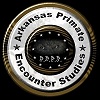|

|
| Drawing by Catharina Presezak |
The Washington Times, Washington, D.C., November 21 2002
On Bigfoot's Trail
Texas group pursues search for Sasquatch of the South
By Jessie Milligan
Fort Worth Star-Telegram
A 13-year-old boy jumping on his trampoline
in his front yard hears his dog barking and looks up to the forest's edge. He later tells Bigfoot investigators he saw a creature
similar to a gorilla looking at him.
His mother believes him, and says she has found large footprints near her bedroom
window. The incident is one of several reports that have come in from the Pat Mayse Lake area north of Paris, Texas. In the
dead of night, they wait for the giant swamp ape they believe lurks along the creek bottoms of Texas, Arkansas and beyond.
Other
examples of recent Bigfoot sightings in Texas, Arkansas and beyond, according to the Texas Bigfoot Research Center in Dallas,
include:
Late fall 2001: A hunter near Marshall puts down apples to attract deer, only to look up and see what he
says was an apelike creature standing 7 feet tall holding a deer hindquarter. The creature collects the apples and leaves.
Spring 2000: A couple driving between Lufkin and Longview report seeing an 8-foot-tall auburn-colored creature walk
upright out of the woods.
In the dead of night, researchers from the center wait for the giant swamp ape they believe
lurks along the creek bottoms in the Southwest.
Long after midnight, horrible screams jolt them upright. Did the recording
device catch it? That was no panther, they whisper to one another. It sounded animal, all right. Something of a cross between
a growl and a scream.
Chris Neal leaves his father's side at their post along the South Sulphur River and finds his
way to the rest of the group that is hoping to prove the existence of the legendary Southern Bigfoot -- also known as a monster,
wild man, Sasquatch, or an elusive ape native to North America.
About 90 Bigfoot sightings have been reported in Texas,
the most recent one in August by a boy near Paris.
This October night was awash with heavy rains and not turning out
as planned. If not for the weather, a small airplane would have taken a night flight over the bottomlands of the river, near
Copper Lake north of Greenville. The pilot would have radioed coordinates to a ground crew if his infrared equipment had detected
any movement.
John Neal, 57, of Garland and son Chris, 36, of Sachse were part of the ground crew, along with other
members of the Texas Bigfoot Research Center, the name for a group of Bigfoot hunters who maintain a center only in cyberspace,
www.texasbigfoot.com.
If the pilot had given the signal, the Neals were to have rushed through the bottomlands and
helped capture photographic proof that an 8-foot-tall Bigfoot lives, breathes, twists trees down to mark territory, steals
livestock and garden vegetables, and fills swamps and woods with unworldly hollers.
The search for a Southern Bigfoot
began in earnest in the late 1960s after several large-ape sightings were reported in Fouke, Ark., 15 miles southeast of Texarkana.
The sighting reports were popularized by the movie "The Legend of Boggy Creek", released in 1972. The low-budget docu-drama
featured real folks who had reported strange and terrifying encounters with an apelike animal.
"The Legend of Boggy
Creek" was the inspiration for the founders of the Dallas-based Texas Bigfoot Research Center three years ago. They seek to
photograph Bigfoot. They do not wish to kill one, though they wouldn't mind if a deer hunter called, saying: "I just shot
the weirdest thing..."
The group of about 30 people has been using high-tech equipment, all-night stakeouts, baits
and an Internet database of sighting reports in an effort to find solid proof that Bigfoot is real.
To accept the
idea of a swamp ape requires following the believers up a ladder of logic. Each rung is a plausible, although often vague,
hypothesis. The ladder has not led to anything tangible, but it does serve to prop up the fascination.
The first step
toward acceptance is this: It is possible for an apelike creature to live in the South.
"The climate and ecology are
right for primates," says Monica Rawlins of Livingston, a manager with a Texas-based department store and one of the Bigfoot
researchers.
The federal government, citing environmental reasons, recently chose Louisiana for a haven for former
research chimps. So Miss Rawlins asks why big, wild primates couldn't live in Southern swamps as well?
Then comes
the physical evidence. Several examples of what appear to be Bigfoot footprints have been found in Arkansas and Texas. They
are more than a foot long, and usually are not found on the side of a road, where a prankster might have left them, but far
out of the way.
These "prints" frequently have just three or four marks that resemble toes, unlike the Northern Sasquatch,
which is said to have left five-toed prints.
"They don't have much habitat to roam in the South. I believe that the
lack of toes in Southern Bigfoot is the result of inbreeding," says Chester Moore Jr. of Orange, Texas, a free-lance outdoor
writer.
Hair samples collected by the group have been sent to DNA test labs and the results have come back as "unknown
species, unknown primate," says Craig Woolheater, a Dallas software programmer and co-founder of the Texas Bigfoot Research
Center.
Photo evidence? The group keeps a surveillance camera posted at a secret spot along the Sulphur River, a frequent
site for Bigfoot reports in Northeast Texas and Arkansas. The Red River and Sabine River also have yielded reports. The cameras
have not captured a conclusive image.
Then comes the evidence that has to do with scent and sound. Bigfoot sightings
are often accompanied by reports of rank odors. Folks who wait in the woods at night also report hearing screams.
"I've
traveled around the world as an outdoor writer. The only thing I've heard that resembles that noise is the one made by the
howler monkey in South America, only angrier," Mr. Moore says.
Most intriuguing to the researchers are the stories
from scared children and farmers drivers who say the beast has crossed their paths.
Ken Marvel of Arlington interviews
people who report a Bigfoot sighting. The Texas Bigfoot Research Center does not give polygraph tests, but instead relies
on judging the character of the person doing the reporting.
Occasionally reports are discarded as too outlandish,
but many are logged into the group's computer database as probable sightings.
"Something happened to these people.
I can see it in their eyes and hear it in the emotion in their voice. What are they going to get out of lying to me?" says
Mr. Marvel of the interviews he finds credible.
The swamp screams aren't the only thing that sustains fascination
among Bigfoot believers. An unknown wild thing holds an emotional appeal as well.
Often when people talk about Bigfoot,
they use words that describe characteristics or concepts they admire, things they may find within themselves.
"He's
not a myth. He's always been with us, shy, powerful and free," Maryland writer and Bigfoot aficionado Fred Grimmnitz said
at a recent Texas Bigfoot Research Center convention, attended by about 200 people in Jefferson.
As the narrator in
The Legend of Boggy Creek says: "I'd almost like to hear that terrible cry again just to be reminded that there is still a
bit of wilderness left, and there are still mysteries that remain unsolved and strange, unexplained noises in the night."
Article reprinted from Texas Bigfoot Research Center
http://www.texasbigfoot.com/watimes1.html
|

